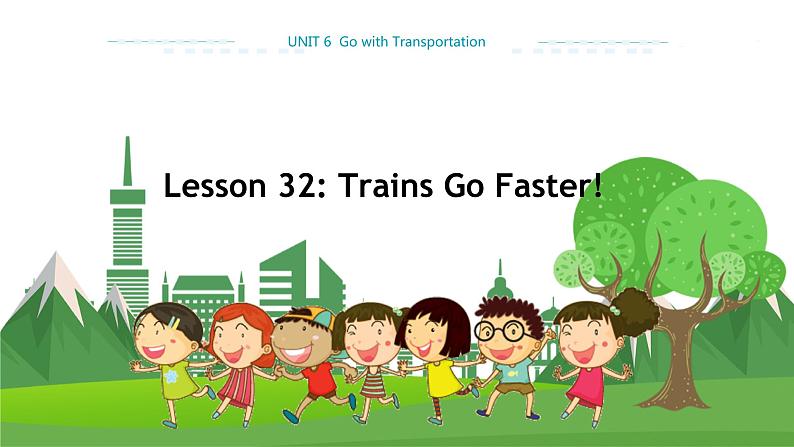










所属成套资源:冀教版英语八年级上册PPT课件+教案+学案全套
初中英语Unit 6 Go With Transportation !Lesson 32 Trains Go Faster !教学ppt课件
展开
这是一份初中英语Unit 6 Go With Transportation !Lesson 32 Trains Go Faster !教学ppt课件,文件包含河北教育版中学英语八年级上UNIT6Lesson32教学课件pptx、32docx等2份课件配套教学资源,其中PPT共22页, 欢迎下载使用。
UNIT 6 Go with Transportation!Lesson 32: Trains Go Faster!设计说明首先,展示第一列火车和现代动车的图片,并就此询问学生问题,由此导入本节课;然后,学习本节新单词和短语;接下来,通过结对练习,训练提高学生的口语能力;再次,设置听课文原文并回答问题环节,通过听力练习,训练学生边听听力边捕捉关键词句的能力;播放课文原文并让学生根据标准音频跟读模仿,熟悉课文内容,同时训练学生的朗读水平;最后,通过本节练习题,检验学生对所学知识的掌握程度,达到学以致用的目的。 教学目标通过本课节的教学,学生达成以下目标:1.知识目标:掌握单词:wheel,born ,passenger ,railway,most,station,standard,speed接触单词:steam,engine,easily,per,steam engine短语和句型:be born,get on/off 2.能力目标:能读懂描述火车发展史的短文;能向他人介绍火车的发展史。3.情感目标: 让学生学会用发展的眼光看待世界。重点难点1. 重点:掌握本课节的重点单词、短语和句型。2. 难点:向他人介绍火车的发展史。教学准备PPT课件;课文朗读的音频。授课时数1课时教学过程Step 1 Warming upShow the students the pictures of trains and get the students to think about the following questions: 1.When was the first railway born?2.What is the fastest speed of today’s trains?Answers:1. In 1804.2. About 500 kilometres an hour.Step 2 PresentationLearn the new words.wheel n. 车轮;轮子born v. 出生;诞生;产生(仅用于被动语态)passenger n. 乘客railway n. 铁路most adj.(many或much的最高级)大多数的;最多的adv. (much的最高级)最n. 最大量;最多数station n. 站;所;车站standard n. 标准;规格speed n. 速度steam n. 蒸汽engine n. 发动机;引擎easily adv. 容易地 per prep. 每,每一steam engine蒸汽机be born 出生;产生;形成get on/off 上/下(车、船等)Step 3 Pair work 1.Get the students to think about the following questions:How do you usually travel to other cities?Talk about your first time taking a train.2. Ask the students to talk about their experiences in pairs.3. Choose some students to talk about their experiences.Step 4 Listening1.Play the recording of the text on page 84.2. Ask the students to fill in the blanks with the words they hear. (1) During the 1830s,countries all over the world started to build________.(2) Trains may have no________in the future.3. Check the answers in groups.Answers: (1)railways (2)wheelsStep 5 ReadingTask 11. Play the recording of the text on page 84. 2. Ask the students to listen to the text and repeat.Task 21. Get the students to read the text again.2. Fill in the blanks.Time What happened?in the 1700s in the 1760s in 1804 after 50 years 3. Check the answers in groups.Answers: Time What happened?in the 1700sMany scientists worked on steam engines.in the 1760sA scientist in England put steam engines and wheels together:the stream train.in 1804The first train engine was born in England.after 50 yearsMany countries had railways and train stations.Task 31. Ask the students to read the text and answer the questions. (Let’s Do It! No. 1) (1) Where was the first train engine built?(2) When did the first passenger railway open?(3) How fast do today’s trains go?(4) What might future trains be like?2. Check the answers in groups.Answers: (1) In England. (2) In 1825. (3) Today’s high-speed trains can travel at about 300 kilometres per hour. The fastest trains can go about 500 kilometres an hour.(4) Maybe trains will have no wheels and ride on air in the future.Step 6 Listening1.Listen to the dialogues and tick the correct information. (Let’s Do It! No. 2)(1) □ in 1804 in 1825 in 1830(2) □ 30 kilometres an hour 45 kilometres an hour 54 kilometres an hour(3) □ seven seventeen seventy(4) □ 50 kilometres an hour 500 metres an hour 500 kilometres an hour2. Check the answers in groups.Answers: (1) in 1804 (2) 45 kilometres an hour (3) seventy (4) 500 kilometres an hourStep 7 Practice1. Complete the dialogue with the correct forms of the words in the box. (Let’s Do It! No. 3) Tom: Hello John. How are you doing?John: Hi Tom. I’m doing well. Have you been to our new______________ ______________?Tom: Not yet. How about you?John: I went there last month. It’s bright and beautiful. It’s easy for___________to get on and off the train. It was exciting. The train went really fast. It can reach a top _____________of 500 kilometres an hour.Tom: That’s really fast! I hope to ride it soon.2. Check the answers in groups.Answers: railway station,passengers,speed3. Read the passage and answer the questions. (Let’s Do It! No. 4)Over two thousand years ago, Chinese people invented kites. Kites can fly like birds, but they can’t take people up into the sky. Hundreds of years later, the Wright brothers made the first successful experiment. A machine carrying a man rose into the sky using its own energy. It was the first plane. Inventors went on to improve planes. Two engineers, Frank Whittle of the U.K. and Hans Von Ohain of Germany, developed the jet plane during the late 1930s.(1) Who invented kites?(2) Can kites take people up into the sky?(3) Where was Frank Whittle from?4. Check the answers in groups.Answers: (1) Chinese people invented kites.(2) No, they can’t.(3) He was from the U. K.Step 8 Language points 1. In the 1700s, many scientists worked on steam engines. 18世纪,许多科学家致力于发明蒸汽机。 work on 从事于……; 继续工作,致力于That teacher worked on in the office until eleven o’clock last night.昨晚那位老师在办公室工作到十一点。The scientists are still working on inventing new methods of reaching outer space today.今天科学家们仍致力于发明到达外层空间的新方法。2. In the 1760s, a scientist in England found a way to put steam engines and wheels together. 在18世纪60年代,在英国的一位科学家发明了把蒸汽机和轮子结合在一起的方法。(1)in the 1760s 意为“在18世纪60年代”。in the 1760s = in the 1760’s, “in the + 年代的复数或所有格”意为 “在……世纪……年代”。He was born in the 1950s.他出生在20世纪50年代。(2) a way to do sth. 意为“做某事的方法”,也可以用a way of doing sth.来表示。Do you know the best way to learn Chinese? = Do you know the best way of learning Chinese? 你知道学习语文的最好方法吗?(3) put ... together 意为“把……放在一起”。You can’t put salt and sugar together. 你不能把盐和糖放在一起。3. The Rocket was the most famous early engine.“火箭号”是最著名的早期机车。most〔副词〕最可与多音节或部分双音节的形容词或副词连用,构成最高级。 Tea is one of the most popular drinks in the world.茶是世界上最受欢迎的饮料之一。【拓展】①most〔形容词〕意为“大多数的”,只能作定语。most还是many,much的最高级, 意为“最多的”。 Most students like listening to popular music.大多数学生喜欢听流行音乐。 She has the most friends in our class.在我们班她的朋友最多。 I spent the most time on the first question.我在第一个问题上花的时间最多。②most〔代词〕最大量;大多数,大部分;大多数人 He spends most of his time playing computer games.他把大多数时间用在了玩电脑游戏上。③most〔副词〕最大,最高,最多 表示程度。What did she enjoy(the)most?她最欣赏的是什么?Step 9 Homework1. Remember the new words and expressions in this lesson.2. Preview Lesson 33.当堂达标I.单项选择。1. __________,not every family could buy a car.A. In 1960s B. In the 1960s’C. In the 1960 D. In the 1960s 2. —What’s that in the picture?—I think it’s __________engine. A. a B. an C. the D. /3. A car is running __________ about 100 kilometres per hour. A. in B. on C. at D. from4. The questions aren’t difficult. You can answer them __________. A. easy B. easily C. easier D. easiestⅡ. 根据汉语意思写出短语。1. 蒸汽机__________ 2. 出生;产生;形成__________ 3. 上/下(车、船等)__________4. 从事…… __________5. 全世界__________Ⅲ. 根据汉语意思完成句子。1. 在18世纪60年代,一位英国科学家发现了一种把蒸汽机与车轮结合在一起的方法。In the 1760s,a scientist in England found ______ ______ _______ _____ steam engines and wheels together. 2. 我们把橘子和苹果放在一起。We _______oranges and apples________. 3. 在这三个男孩中,丹尼拥有最多的玩具汽车。Of the three boys,Danny has _____ _______toy cars. 答案:I. 1~4 DBCB II. 1. steam engine 2. be born 3. get on/off 4. work on 5. all over the worldⅢ. 1. a way to put 2. put, together 3. the most 板书设计UNIT 6 Go with Transportation!Lesson 32: Trains Go Faster!wheel, born, passenger, railway,most, station,standard,speed in the 1760s = in the 1760’swork on a way to do sth.put ... together be bornget on/off教学反思
相关课件
这是一份初中英语冀教版八年级上册Lesson 6 Jenny's Week教学ppt课件,文件包含河北教育版中学英语八年级上UNIT1Lesson6教学课件pptx、6docx等2份课件配套教学资源,其中PPT共28页, 欢迎下载使用。
这是一份初中冀教版Unit 6 Go With Transportation !Lesson 36 Clean Cars ?教学课件ppt,文件包含河北教育版中学英语八年级上UNIT6Lesson36教学课件pptx、36docx等2份课件配套教学资源,其中PPT共21页, 欢迎下载使用。
这是一份冀教版八年级上册Lesson 34 Flying Donuts教学ppt课件,文件包含河北教育版中学英语八年级上UNIT6Lesson34教学课件pptx、34docx等2份课件配套教学资源,其中PPT共29页, 欢迎下载使用。











